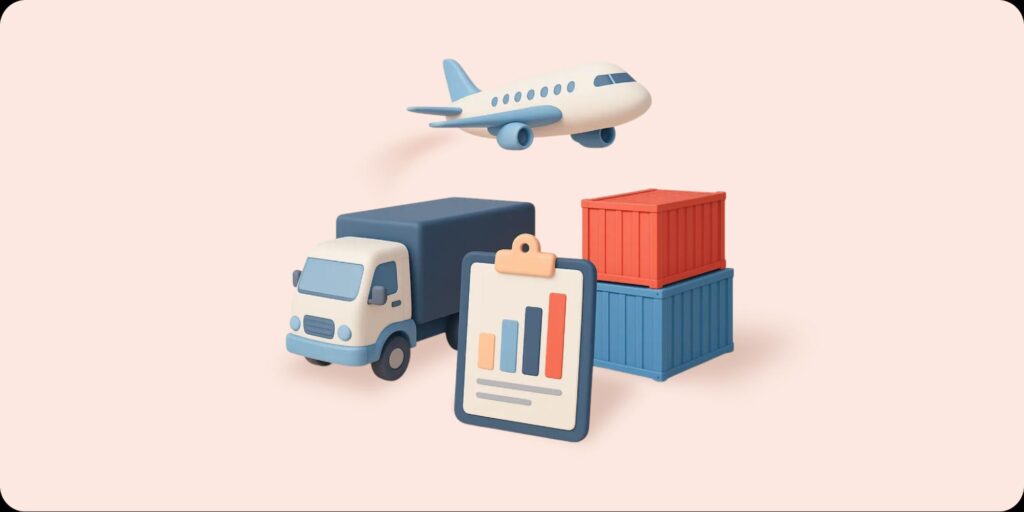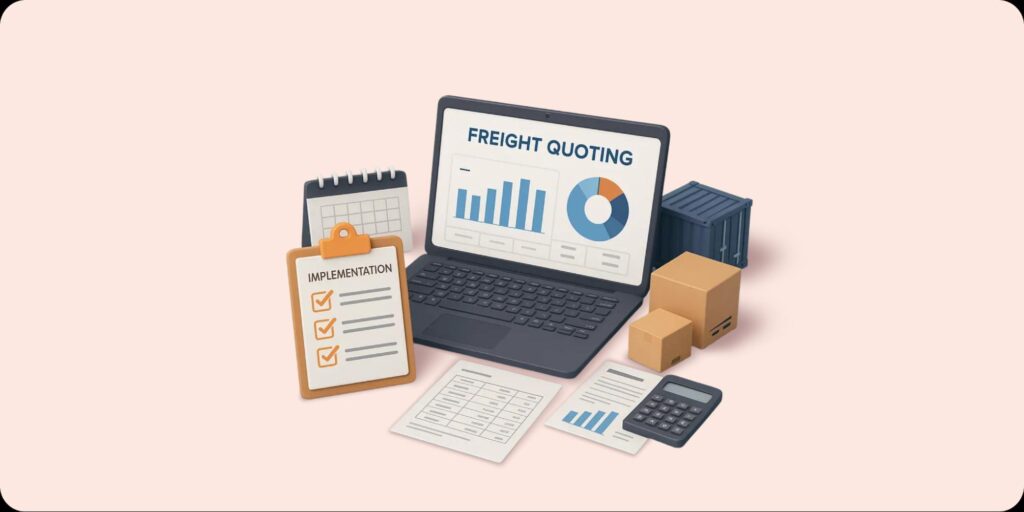Key Takeaways
- Freight rate management centralizes and automates rate tracking, helping forwarders cut costs through smarter carrier selection and real-time pricing visibility.
- Standardized rate templates and automation tools reduce quoting time and manual errors, improving team efficiency and decision-making.
- Monitoring real-time market trends and integrating with carrier APIs ensures rates remain accurate, up-to-date, and competitive.
- Rate management platforms enable faster quote generation, SLA tracking, and performance benchmarking, which is key to maintaining high margins and customer satisfaction.
- Wisor reduces quote turnaround by 85%, automates rate updates and approvals, and delivers real-time analytics to boost win rates and quoting accuracy.
What is Freight Rate Management?
Modern freight logistics rely on a complex web of transport modes, carriers, and fluctuating market factors, all of which directly impact shipping rates. Freight rate management refers to the process of controlling and optimizing these costs through strategic tracking, analysis, and negotiation.
In a volatile pricing environment, forward-thinking freight forwarders and logistics companies use digital tools to manage rates in real time. Technologies like automation, AI-based analysis, and trend monitoring enable smarter carrier and route selection, ensuring shipments arrive on time, at the best possible cost.
Why Freight Rate Management Matters
Freight rate management is a core component of freight forwarding. It enables control over shipping expenses by providing visibility into how logistics providers price their services. This understanding forms the foundation for optimization, negotiation, and faster, more efficient decision-making. Both freight forwarders and logistics companies can benefit from leveraging freight rate management as part of negotiation, carrier selection, and mode choice.
- Helps Cut Costs: Freight rate management provides visibility into pricing trends, cost drivers, and historical rate patterns across carriers, modes, and routes. This enables strategic decisions such as renegotiating rates or switching to more cost-effective carriers, ultimately driving down expenses.
- Speeds Up Operations: By identifying bottlenecks and inefficiencies, rate management streamlines workflows, supports agile decision-making, and improves coordination across logistics functions. Many tools also enable automated selection to speed up operations.
- Saves Time on Quotes: Automation tools pull real-time data to compare rates and generate quotes faster, helping your team respond to customer requests quickly and accurately.
- Improves Carrier Communication: Effective rate management includes proactive communication and relationship-building with carriers, creating opportunities for better terms and pricing over time.
3 Types of Freight Rates
Freight rates vary significantly based on the payment structure, route, and contract type involved. In most cases, they’re subdivided into one of three contract types:
1. Contract Rates
Contract rates are fixed-term agreements with:
- Flat-rate or fixed-rate pricing over a set term
- Predefined routes and modes
- Service level agreements
2. Spot Rates
Spot rates are on-demand pricing adjusted to real-time market rates, typically used for urgent and overflow shipments.
- One-time rates with on-demand pricing
- Subject to real-world fluctuations
3. Marketplace Rates
Marketplace rates are similar to spot rates, but are handled through digital freight platforms and bidding systems.
- Transparent, competitive rate listings
- Instant quote comparisons across carriers
| Contract Rates | Spot Rates | Market Rates | |
| Term | 12+ months | Duration of shipment | Duration of shipment |
| Route | Agreed in the contract | One-time agreement | Negotiated |
| SLA | In the contract | Negotiated | Included in marketplace terms |
| Transparency | Only in the contract | No | Yes |
| Rate Change | On contract end | Real time | When carrier updates rates in the marketplace |
| Pros | Leverages volume agreements to fix favorable rates over a longer term for reliable pricing and carrier availability. | Delivers flexibility for one-off routes, last-minute changes, and to meet overflow needs from existing carriers. | Carriers are forced into competitive pricing to win contracts, creating a favorable environment for forwarders. |
| Cons | Volumes and routes are fixed, so contracts do not offer the flexibility you might need. | Rates can be high, especially if no other carriers are available for the shipment. | Each shipment must be planned and negotiated separately, without fixed terms, SLAs, or pre-agreed contracts to streamline future bookings. |
Best Practices for Freight Rate Management
Implementing best practices for freight rate management typically means digitizing, automating, and improving standardization in every part of the process. By reducing manual workflows, you’ll speed up rate comparison and quote selection, reduce errors, and create opportunities for algorithmic data analysis and rate selection.
- Use Standardized Rate Templates: The more you standardize freight contract management, the more cost-effective it will be. Standardized rate templates allow automation, automatic comparison, and faster document creation and workflows. For instance, converting rate cards from different carriers into a standardized template enables seamless comparison and supports automation of quote selection.
- Monitor Market Changes Frequently: Freight rates are extremely volatile. Real-world rates impact costs instantly. Monitor market changes in real-time to ensure rate selection remains accurate. For contract rates, implement strong contract management so you know when rates are subject to change.
- Automate Manual Workflows: From rate comparison and indexing to automatic document creation and submission, automation saves time, improves accuracy, and enables split-second decision-making to net the best deals.
- Maintain a Centralized Rate Repository: Indexing historical trends, saving rates, and benchmarking rates creates opportunities to compare against those trends and make smarter future decisions. Especially if you’re automating rate comparison and selection, maintaining benchmarks is a must.
- Train Logistics and Sales Teams Regularly: Ensure logistics and sales teams stay informed about rate changes, market conditions, quote strategies, and best practices for using digital rate management tools.
How Freight Rate Management Works
Freight rate management is the process of maintaining a database of rates, analyzing long-term trends, and using that freight rate data to generate and share quotes across routes and cargo types.
- Collecting and Uploading Carrier Rates: Use an API to import or manually load carrier rates. Modern rate fluctuations mean manual uploads are not sustainable, so look for carriers that can integrate with your rate management system.
- Normalizing and Standardizing Rate Data: Analyze data and process it into a single index. A centralized rate management system database can feed into rate analysis, reporting, historical indexing, etc.
- Automating Quote Generation and Sharing: Leverage AI to automatically pull carrier rates from your index to generate quotes and quote selection, reducing time and costs to deliver quotes.
- Managing Validity, Expiry, and Updates: Automatically flag and remove quotes that are no longer valid. Tools like Wisor track rate changes in real time and issue updates as rates change or expire.
- Tracking Rate Usage and Performance Metrics: Track long-term performance and carrier usage over time. For example, low rates offset by not meeting SLAs aren’t as low as they look upfront.
Challenges in Freight Rate Management
Freight rate management is extremely complex, with hundreds, if not thousands, of variables. Rate fluctuations, carrier changes, and communication all present major obstacles to rate managers.
| Problem | Potential Solution | |
| Inconsistent Rate Formats Across Carriers | Individual carriers maintain their own rate cards and price factors. | Convert all incoming rates to a rate card template to ensure consistency and easy comparison. |
| Manual, Time-Consuming Quote Generation | Manually generating a quote can involve pulling data from multiple carriers to compile a quote. | Freight rate management software automatically pulls real-time rates from across carriers to generate quotes. |
| Outdated Rate Sheets and Price Fluctuations | Rates change rapidly based on real world-conditions, and manual updates are often impossible. | Integrating rates via API pulls current rates directly from the carrier, so rate sheets are always up-to-date. |
| Delayed Carrier Responses and Missed Bookings | Carriers may be slow to respond to emails or phone inquiries, resulting in missed booking windows and service-level agreement (SLA) violations. | API integration allows carriers to see quotes directly in their system, speeding up response time and improving booking. |
| Difficulty Tracking Rate Expiry Dates | Customers don’t always respond to quotes quickly, while real-world rates continue to update, but tracking quotes manually requires significant man-hours and attention. | Freight rate management software can automatically track rate changes and send updates to quotes as rates expire. |
Did You Know?
Roughly 90% of shippers now expect digital quote turnaround in under two hours, but most forwarders still take over six, costing the industry billions annually in lost conversions.
Pros and Cons of Freight Rate Management
Freight rate management software delivers visibility, insights, and opportunities for significant cost savings to freight forwarders. At the same time, rate management can introduce complexities and costs.
Pros
- Faster Quoting: Quotes are automatically generated from a rate index for reduced man-hours and faster response times.
- Better Cost Control: Understanding margins and complex cost structures across every leg of a journey keeps quotes accurate and margins high.
- Less Manual Work: Freight rate management software automates processes around rate updates, quoting, and quote updates, saving your team time.
- Easy Rate Tracking: With carrier rates benchmarked and ideally integrated via API, you can automatically see rates across pricing contracts, spot rates and tariffs, and marketplaces.
Cons
- Setup Time: Expect to invest anywhere from a few weeks to a few months for a simple rate management software solution or several months for an enterprise resource planning solution.
- Keeping Data Updated: Outdated data is worse than no data. You’ll have to connect to data sources via API to automatically update and refresh rate cards and indexes.
- System Integration Requirements: Your freight rate management platform must integrate with your carrier’s transport management solutions and ERP.
Data and Metrics to Track in Freight Rate Management
Effective freight rate management isn’t just about collecting rates – it’s about tracking the right metrics to improve quoting, carrier selection, and overall performance. By monitoring the data points below, logistics teams can make smarter decisions, reduce costs, and win more deals with greater efficiency.
- Quote-to-Booking Conversion Rate: Monitoring your quote-to-booking conversion rate reveals how competitive your pricing is, allowing you to fine-tune quotes and increase win rates.
- Rate Accuracy and Error Frequency: Understanding rate accuracy delivers insights into the margin needed to cover potential errors in quotes. Introducing real-time data and AI tools to auto-generate quotes reduces this to almost zero.
- Average Cost Per Shipment or Lane: Tracking costs across shipment, lane, and route delivers insights into normal costs to identify peaks so you know when to choose different routes or lanes.
- Carrier Performance vs. Agreed SLA: Track when carriers fail to meet SLAs as this adds to costs and detracts from contract cost wins.
- Response Time to Rate Requests: With automated rate response, you can respond to customer requests in minutes.
What to Look for in Freight Rate Management Software
Choosing a rate management system requires evaluating your technology infrastructure, operational requirements, and transaction volume. While there’s no one-size-fits-all solution, you’ll largely want the following features and capabilities in your rate management tool.
1. Real-Time Rate Updates and Expiry Tracking
Pulling carrier rates in real-time is a must-have. From there, you should look for expiry tracking and quote updates, so customers always have a valid quote.
2. Support for Multiple Carrier Formats and Integrations
Look for automatic rate-card creation using a standard template or options to pull different formats from across your carriers. Otherwise, you’ll have to manually create every rate card and program every API to put data in the right fields.
3. Automated Quote Generation and Distribution
If the quote data is already in the system, you should be able to automatically generate a quote and submit it to the customer.
4. Centralized Rate Repository with Search and Filter Tools
While much of the quotation should be handled automatically, you’ll still want to manually review rates. Look for a rate management tool with a centralized repository and options to search and filter the carriers or rates you want.
5. Built-In Margin Control and Quote Approvals
While some level of manual review is always good, more automation reduces time and improves cost savings. Rate management tools should include margin control and automatic quote approval whenever quotes meet standards.
6. Analytics and Reporting on Rate Usage and Trends
Understanding rate usage, booking conversion, and rate trends delivers opportunities to optimize and win more deals. Your rate management tool already has the data, make sure you can use it.
7. Built to Scale with Your Freight Volume
Moving to a new rate management system is time-consuming and costly. Make sure your software meets your scaling needs now and in the future. Usually, it’s best to set a benchmark for at least five years in the future.
8. User-Friendly Interface for Operations and Sales Teams
Freight rate management software is supposed to save time and boost your margins. That won’t be the case if you constantly have to train staff on how to use it. Look for a simple interface that’s usable by both operations and sales teams.
Expert Tip: Standardize and Automate to Win More Quotes
- Centralize all rate data: Build a rate index that includes contract, spot, and marketplace rates, tagged by carrier, lane, validity, and service level. This enables fast comparisons and margin-based selection logic.
- Standardize incoming rate sheets: Convert all rate inputs to a uniform template. This is critical to enable automation for quote generation and reduce time spent reformatting disparate carrier data.
- API-first carrier integration: Prioritize working with carriers who offer real-time rate feeds. Manual uploads are unsustainable, especially in volatile markets, and delay quote turnaround by hours.
- Track quote expiration and usage: Set up automated expiry checks for each quote. Forwarders lose millions annually from quoting expired rates that must be manually revised after customer follow-ups.

Insight by
Nadav Shitrit
VP of AI, Wisor
How Wisor Optimizes Freight Rate Management and Simplifies Quoting Workflows
Simplify real-time quoting with AI that automatically updates, stores, and applies rate data to generate fast, accurate quotes. Using Wisor, freight forwarders can generate comprehensive door-to-door quotes in as little as 60 seconds, automatically track rate changes and quote expiration, and win more deals.
- Instantly Identifies the Best Freight Rates: Leverage a rate index, complete with real-time updates to instantly identify and select the best quotes per lane or route.
- Automates Quote Creation and Sharing: Automatically generate quotes and approvals based on margin settings so customers get quote responses in minutes, and you win more deals.
- Integrates Seamlessly with Any Carrier or TMS: Link real-time freight management and enterprise resource planning data via API to ensure rate updates and carrier communication are close to instant.
- Delivers Clear, Actionable Pricing and Performance Reports: Get smart insights into pricing, carrier performance, and trends so you can see total costs per carrier and deliver accurate quotes that protect your margin.
- Built Around an Intuitive, User-Centric Dashboard: Get started right away with a user-friendly dashboard and intuitive controls that don’t take weeks to master.
Conclusion
Freight rate management creates opportunities for freight forwarders to optimize processes, relationships, operations, and margins. With the right freight management software, you leverage real-time data to deliver improved quotes faster, so you win the right deals.
Traditional freight quoting is manual, slow, and error-prone. A rate management platform like Wisor replaces it with automation, clarity, and speed, giving forwarders the tools to scale smarter, close faster, and win more profitable deals.
Ready to see how Wisor’s digital features can enhance rate management, increase booking conversions, and automate quoting? Schedule a demo to see it in action!






